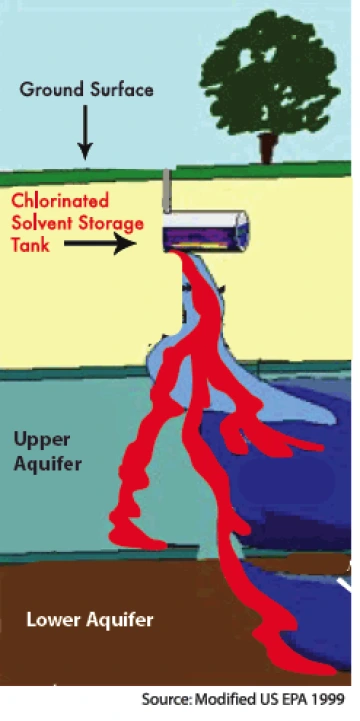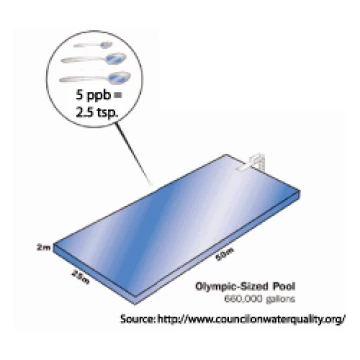TCE stands for trichloroethylene. It is considered to be a solvent, which is a liquid that can dissolve oily and greasy substances.
TCE has been introduced into the environment because people use it to clean grease from metal, especially airplane parts. Also, dry cleaners used a closely related solvent known as PCE (perchloroethylene) to remove the grime from dirty clothes. Once PCE enters the environment, it can change and form TCE.
In the past, people did not understand that TCE might affect humans and the environment in a negative way. Because of this lack of knowledge, it was not properly contained. In addition, if stored improperly, TCE can leak into the environment. Today, TCE is disposed of by burning it in a specially built high temperature incinerator.

How does TCE affect our Environment?
TCE remains in soil and groundwater supplies for a long period of time. Groundwater is where we primarily obtain our drinking water in the southwestern United States and northern Mexico.
How does TCE affect your Health?
Scientists have found that TCE affects people when they are exposed to it. TCE mainly enters the body by drinking water. It also enters the human body when it is inhaled or absorbed through the skin. The health effects of TCE are dependent on the amount and duration of exposure. Repeated high exposure to TCE can have long-lasting and possibly permanent effects.
Very high concentrations of TCE can cause humans to pass out, stop breathing, or die. It has also been shown that high concentrations of TCE can impair heart, nerve, kidney, and liver functions.
With low concentration levels, humans may develop an allergic reaction, such as a skin rash, have decreased coordination, or have difficulty concentrating. Also, dizziness, headaches, and other irritations may occur. Low concentrations over a long period of time may cause cancer in the intestine, liver, and kidney.
Studies suggest that the way your body deals with TCE may also depend on your family history or your genetic make up.
What are the Government policies concerning TCE?
The US Environmental Protection Agency (US EPA) is the federal agency responsible for monitoring TCE in drinking water. They have created standards or guidelines for its management. Drinking water standards for TCE state that it must be less than 5 micrograms per liter (µg/L) or parts per billion (ppb). This is equivalent to adding 2.5 teaspoons of TCE into an Olympic sized swimming pool (see lower right figure).
If there is TCE in water we can be exposed by drinking, swimming, or showering. Breathing air and shower vapors that have TCE are other forms of exposure. Coming into contact with soil or dust that has been contaminated with TCE is another source.

How can I reduce TCE exposure in my home?
The best way to prevent health problems related to TCE exposure is with personal knowledge. It is recommended that individuals learn about the quality of their drinking water. Information about your drinking water is available to the public by contacting your local water provider. Lastly, be aware of the historical background of the area in and around your home. Find out if your home was built near an old industrial, dry cleaners, or garbage dump site.
The amount of TCE in drinking water can be reduced by installing a home activated carbon filter system. It is recommended that a qualified technician install your filter system in order to assure it works properly. It is important to replace the filter as recommended by the manufacturer since activated carbon filters do not work forever.
Want to Learn more about TCE?
- Arizona Department of Environmental Quality
- Agency for Toxic Substances and Disease Registry
- US EPA:Trichloroethylene in drinking water
For more information, please contact:
Denise Moreno Ramírez
Community Engagement Coordinator
1110 East South Campus Drive
Tucson, Arizona 85721
Tel: 520.626.9049
dmoreno@pharmacy.arizona.edu

